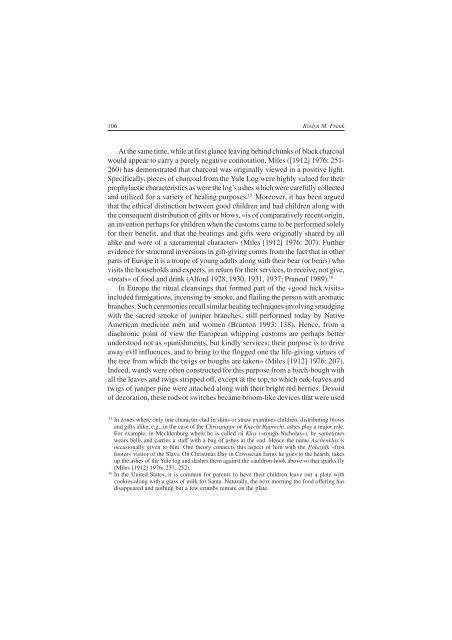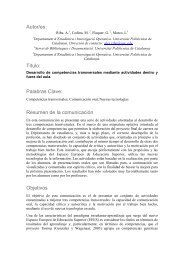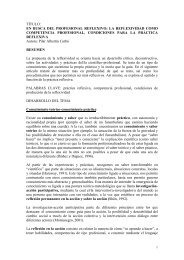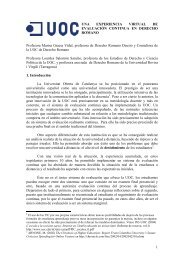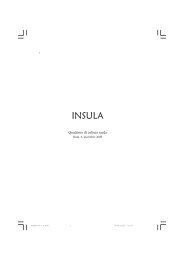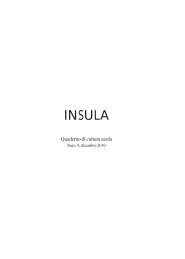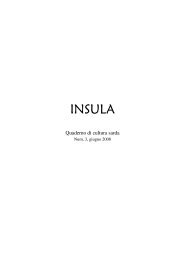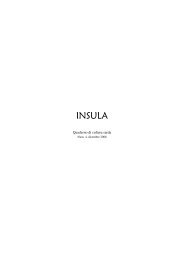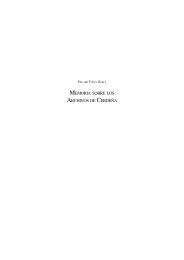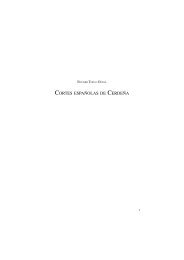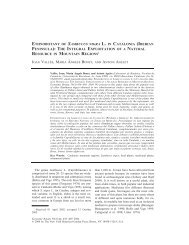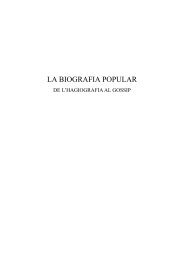Impaginato 5.p65 - Universitat Rovira i Virgili
Impaginato 5.p65 - Universitat Rovira i Virgili
Impaginato 5.p65 - Universitat Rovira i Virgili
You also want an ePaper? Increase the reach of your titles
YUMPU automatically turns print PDFs into web optimized ePapers that Google loves.
106<br />
Roslyn M. Frank<br />
At the same time, while at first glance leaving behind chunks of black charcoal<br />
would appear to carry a purely negative connotation, Miles ([1912] 1976: 251-<br />
260) has demonstrated that charcoal was originally viewed in a positive light.<br />
Specifically, pieces of charcoal from the Yule Log were highly valued for their<br />
prophylactic characteristics as were the log’s ashes which were carefully collected<br />
and utilized for a variety of healing purposes. 15 Moreover, it has been argued<br />
that the ethical distinction between good children and bad children along with<br />
the consequent distribution of gifts or blows, «is of comparatively recent origin,<br />
an invention perhaps for children when the customs came to be performed solely<br />
for their benefit, and that the beatings and gifts were originally shared by all<br />
alike and were of a sacramental character» (Miles [1912] 1976: 207). Further<br />
evidence for structural inversions in gift-giving comes from the fact that in other<br />
parts of Europe it is a troupe of young adults along with their bear (or bears) who<br />
visits the households and expects, in return for their services, to receive, not give,<br />
«treats» of food and drink (Alford 1928, 1930, 1931, 1937; Praneuf 1989). 16<br />
In Europe the ritual cleansings that formed part of the «good luck visits»<br />
included fumigations, incensing by smoke, and flailing the person with aromatic<br />
branches. Such ceremonies recall similar healing techniques involving smudging<br />
with the sacred smoke of juniper branches, still performed today by Native<br />
American medicine men and women (Brunton 1993: 138). Hence, from a<br />
diachronic point of view the European whipping customs are perhaps better<br />
understood not as «punishments, but kindly services; their purpose is to drive<br />
away evil influences, and to bring to the flogged one the life-giving virtues of<br />
the tree from which the twigs or boughs are taken» (Miles [1912] 1976: 207).<br />
Indeed, wands were often constructed for this purpose from a birch-bough with<br />
all the leaves and twigs stripped off, except at the top, to which oak-leaves and<br />
twigs of juniper pine were attached along with their bright red berries. Devoid<br />
of decoration, these rods or switches became broom-like devices that were used<br />
15 In zones where only one character clad in skins or straw examines children, distributing blows<br />
and gifts alike, e.g., in the case of the Christpuppe or Knecht Ruprecht, ashes play a major role.<br />
For example, in Mechlenburg where he is called rû Klas («rough Nicholas»), he sometimes<br />
wears bells and carries a staff with a bag of ashes at the end. Hence the name Aschenklas is<br />
occasionally given to him. One theory connects this aspect of him with the Polaznik «first<br />
footer» visitor of the Slavs. On Christmas Day in Crivoscian farms he goes to the hearth, takes<br />
up the ashes of the Yule log and dashes them against the cauldron-hook above so that sparks fly<br />
(Miles [1912] 1976: 231, 252).<br />
16 In the United States, it is common for parents to have their children leave out a plate with<br />
cookies along with a glass of milk for Santa. Naturally, the next morning the food offering has<br />
disappeared and nothing but a few crumbs remain on the plate.


